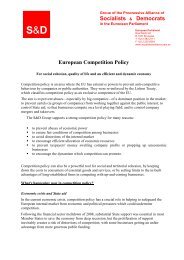TELECOM ITALIA GROUP1. Company descriptionTelecom Italia is a business which operates in every sector of advanced communications. Its activities range fromfixed-line to mobile telephony, from the Internet to media. The group operates both in Italy and abroad, throughwell-known brands such as Telecom Italia, Alice, TIM, Olivetti, La7 and APCom.The Telecom Italia Group is a leading force in fixed-line and mobile telephony, the Internet, the media sector andoffice & systems solutions, and is currently investing heavily with the aim of expanding broadband and opening theway for a new generation of interactive and multimedia services, systems and advanced solutions for both familiesand the business world.Cabling, extensive network infrastructure and leading-edge technologies also underpin the Group's internationalpresence. In Europe, Telecom Italia is currently expanding broadband in France and Germany, and carries 60% of alltraffic between major Mediterranean basin countries. In South America, TIM Brasil has become the country's leadingnationwide GSM line provider, and is the country's number two carrier overall.Where turnover is concerned, revenue in the first nine months of 2006 was € 23 104 million, a 5.2% increasecompared with the first nine months of 2005.This very positive revenue picture is offset, however, by a high level of debt. The Group's net borrowings as at 30September 2006 were € 39 504 m, € 1 811 m less than the position as at 30 June 2006 (€ 41 315 m); this wasattributable to cash generation in the third quarter. Even given this substantial improvement, Telecom Italia stillcarries a mountain of debt. This is the result of a series of events which led to the explosive growth of a level of debtwhich was modest until 10 years ago. The reasons are to be found in a particularly turbulent decade in which therewere many changes both in the ownership structure and at the head of the Group.Chronologically, the most recent change goes back to September 2006, when Marco Tronchetti Provera, the thenChairman and leading shareholder in Telecom Italia, through Pirelli, resigned from the board of directors followingthe Government's outright rejection of his reorganisation plan. He handed over to the lawyer, Guido Rossi, whoreturned to head Telecom Italia, as he had for a few months in 1997.But what are the reasons for the explosion in the Group's indebtedness? To understand this, we need to go back to thetime when the business, having been a public undertaking, moved into private ownership.2. Economic and social effects2.1 Description of LBO (offshore base, activity focus, etc.)It was in 1997, during the Prodi Government, that the need arose to privatise Telecom Italia, a State-owned giantwhich at that time boasted a turnover equivalent to more than € 22 million, a workforce of 124 000 and holdings invarious companies throughout the world, and was the first mobile telephony operator in Italy and the country's firstInternet service provider. It was no easy matter to privatise such a huge group, but the Treasury Minister and theMinister of Industry, in conjunction with the Minister of Telecommunications, had a specific political idea, namelythat Telecom Italia would become the first Italian public company to bring together small savers and the capitalmarket, which at that point was under-developed by comparison with its European partners. There were two types ofownership structure which could be used as a basis: the Anglo-Saxon public company and the typically French 'hardcore' structure. While the first would ensure widespread share ownership with good protection for minorityshareholders, it would also have made the Telecom Italia Group excessively vulnerable, exposing it to acquisitionsby foreign companies (something that the Government did not welcome in such a strategic sector). The publiccompany model also had many negative aspects with regard to corporate governance, such as the agency costsassociated with the marked separation between ownership and control, which could lead to opportunistic behaviouron the part of management. Adoption of the 'hard core' structure, on the other hand, would undoubtedly have broughtabout greater involvement of a stable shareholder base in the company's performance, but would have run counter tothe principle underlying privatisation itself.Although the privatisation of Telecom Italia was adjudged a success from the purely technical point of view, giventhe large number of savers who bought into it, the same cannot be said about the choice of ownership structure.Negative signs of instability, unmanageability, and the lack of a leading shareholder with experience of the industrywho would pursue a clear, agreed goal all emerged in short order.
In October 1998, although the company still actually benefited from a monopoly position and high cash flow, it wasvalued at a multiple of only 1.9 times its net worth, compared with a figure of 3 for Deutsche Telekom (DT) andmore than 4 for France Télécom (FT) and British Telecom (BT). The P/E ratio 6 was 19, compared with 22 for BTand 28 for FT and DT. Franco Bernabè took the helm at the Telecom Italia Group in January 1999; he was a managerwhom the market appeared to favour, given his previous success with restructuring ENI. However, internationalinvestors criticised the Group's financial structure, which carried too little debt by comparison with what could beregarded as the optimum level. The Group's low level of debt, together with its high and stable cash flow (from TIM,especially), were the factors which opened up the possibility of a stock market raid, using high financial leverage.This situation thus made Telecom Italia a potential target. Towards the end of November 1998 it attracted theattention of Roberto Colaninno, the Managing Director of Olivetti; in February 1999, following a series of rumoursof a possible stock market raid, he launched a hostile takeover bid.2.2 Debt structure, alteration of company capital management fees required by LBOThe operation envisaged the involvement of a new company (Tecnost), to be used as vehicle to take on the debtsgenerated by the operation, which would then be transferred to Telecom Italia through a future merger, which thennever took place.In theory the acquisition should have been followed by the merger between Tecnost and Telecom Italia, resulting inthe latter shouldering the debt used to acquire it. According to the analyses carried out by the advisers the debt takenon by 'new Telecom' was supposed to be € 38 billion (€ 5.5 inherited from the pre-acquisition situation, and €32.5 bnfrom the bank loans and bonds constituting the Tecnost 'dowry'). Net borrowings are now close to € 40 000 m.2.3 Management policies and shareholder activismBernabè deployed a range of counter-measures to fight off the takeover bid. The first was a public exchange shareoffer between Telecom Italia ordinary shares and TIM ordinary and savings shares. The official aim was to carry outa merger by incorporation, so as to speed up implementation of the strategy of integrating fixed-line and mobiletelephony, the primary objective of Bernabè's strategic plan. The actual aim was to make Telecom Italia too big amouthful to swallow. If TIM had been incorporated into Telecom Italia this would actually have produced a biggercompany than its predecessor, with more capitalisation, which would then be more difficult to bid for.Colaninno resumed the attack by increasing the offer price (from € 10 per share to € 11.50), and the shareholders'meeting convened by Bernabè for the purpose of rejecting the bid, since it failed to achieve the quorum of 30% of thecapital being represented there, broke up having come to nothing. The Government, which did not support thedefence being deployed by Bernabè, consequently supported Colaninno's operation. The Treasury Ministry wasactually the biggest shareholder and, as such, nominated two members of the Board of Directors. The key point wasthat Government approval was needed for shareholdings of more than 3%; that approval was one of a series of'special rights' which are usually referred to as golden shares. The final defensive measure attempted by Bernabè,namely a merger between Telecom Italia and Deutsche Telekom, was simply dismissed by the market. Theoperation, which was, in fact, a leveraged buy-out of Telecom Italia by Olivetti, was successfully completed andbecame the biggest takeover ever carried out in Europe, and is still one of the biggest in the world in terms of value.However, the price paid has been a high one, namely net borrowings of nearly €40 000 m.2.4 Effects on job creation, labour forceTelecom Italia remains one of the biggest businesses in Italy in terms of both the size of its workforce and itsturnover. However, where jobs are concerned, whereas Telecom Italia Group employed 124 000 people in 1997, by31 December 2005 the workforce had shrunk to 86 531. More than 84% of the Group's workforce is employed inItaly.6 Price/earnings ratio: derives from the ratio between the stock market capitalisation and net profit. Indicates the levelat which the market values earnings.
- Page 1 and 2:
HEDGE FUNDSAND PRIVATE EQUITY -A CR
- Page 3 and 4:
The need for long-term investmentTh
- Page 5 and 6:
On the basis of a coherent analysis
- Page 7 and 8:
The pension fundsWhere does all the
- Page 9 and 10:
3. The target company is merged wit
- Page 11 and 12:
Societies’ response - current nat
- Page 13 and 14:
In most of the case studies, PE inv
- Page 15 and 16:
huge tax advantages when the rate o
- Page 17 and 18:
known to bank supervisors. Those da
- Page 19 and 20:
provide transparency with respect t
- Page 21:
The demand for change and better re
- Page 24 and 25:
industrial policy, focusing on know
- Page 26 and 27:
AcknowledgementsThis report has bec
- Page 28 and 29:
The situation we are facing now is
- Page 30 and 31:
market to promote the knowledge-eco
- Page 32 and 33:
Our desire to separate the single s
- Page 34 and 35:
Typically a single strategy HF oper
- Page 36 and 37:
In most European countries, fund ma
- Page 38 and 39:
It should also be signalled that:
- Page 40 and 41:
Institutional investorsCurrent and
- Page 42 and 43:
leverage in order to benefit from s
- Page 44 and 45:
1.6 The costs, the management fees
- Page 46 and 47:
only remaining way to boost returns
- Page 48 and 49:
A majority of hedge funds have limi
- Page 50 and 51:
Our analysis is that these concerns
- Page 52 and 53:
Average annual returnsTremont HF in
- Page 54 and 55:
1.11. Tendency of crowdingDespite t
- Page 56 and 57:
• Corporate governance:“In the
- Page 58 and 59:
Onshore FoHFsCountryUnitedKingdomGe
- Page 60 and 61:
ItalyBank ofItaly•Specializedasse
- Page 62 and 63:
1.14 Societies’ response - curren
- Page 64 and 65:
Investments are often in individual
- Page 66 and 67:
employed 21 . Leverage effect expla
- Page 68 and 69:
Investments are sold off to other c
- Page 70 and 71:
Private Equity: European trends in
- Page 72 and 73:
time because of the longer holding
- Page 74 and 75:
Bain CapitalPartners 74.7 9Thomas H
- Page 76 and 77:
Sources of new funds raised (2005)C
- Page 78 and 79:
The private equity manager virtuall
- Page 80 and 81:
The fund structuring arrangements f
- Page 82 and 83:
ownership transfers. But buyout cap
- Page 84 and 85:
equity value chain. The main areas
- Page 86 and 87:
of the table but that less mature c
- Page 88 and 89:
UCITS (Undertakings for Collective
- Page 90 and 91:
Article 49Within the framework of t
- Page 92 and 93:
open and secure retail markets and
- Page 94 and 95:
offeree company must give its views
- Page 96 and 97:
In its Communication on worker info
- Page 98 and 99:
est practices, promoting innovative
- Page 100 and 101:
- Work to ensure more consistent an
- Page 102 and 103:
destabilising the financial markets
- Page 104 and 105:
& LBOs invest. It increases financi
- Page 106 and 107:
In particular, incumbent managers o
- Page 108 and 109:
long-term competitiveness of the ac
- Page 110 and 111:
It also leads to further weakening
- Page 112 and 113:
If HFs and LBOs have brought uncert
- Page 114 and 115:
the social responsibilities of comp
- Page 116 and 117:
areas after recapitalisation 11 . I
- Page 118 and 119:
Furthermore, the funds in many case
- Page 120 and 121:
privatised with a view to stimulati
- Page 122 and 123:
asset stripping, and the offering o
- Page 124 and 125:
dividend to Valentia.The second pub
- Page 126 and 127:
***The three country case studies o
- Page 128 and 129:
eturns well below those achieved by
- Page 130 and 131:
investment funds - in the UK alone
- Page 132 and 133:
4.2 The issue of pension fundsThe p
- Page 134 and 135:
One year earlier the British Financ
- Page 136 and 137:
the fund exceeds the highest value
- Page 138 and 139:
5.3 Short sellingHistorically, hedg
- Page 140 and 141:
global financial markets. In 1998 t
- Page 142 and 143:
implications associated with the li
- Page 144 and 145:
The classic source of leverage is l
- Page 146 and 147:
I talk to have got a prayer in the
- Page 148 and 149:
The main reason for the lack of inf
- Page 150 and 151:
7. The need for change to ensure a
- Page 152 and 153:
clearly destructive must be prevent
- Page 154 and 155:
European Union.Part III is going to
- Page 156 and 157:
2. Market transparency - a common i
- Page 158 and 159:
International Settlements in Switze
- Page 160 and 161:
3.2 The main beneficiaries of regul
- Page 162 and 163:
within jurisdictions with enhanced
- Page 164 and 165:
In our view, if we want to promote
- Page 166 and 167:
investors.The EC should set up an i
- Page 168 and 169:
Alternative investment fund manager
- Page 170 and 171:
widely differing impacts of PE acti
- Page 172 and 173:
estrict investment to specific asse
- Page 174 and 175:
Clearly the governance authorities
- Page 176 and 177: paid. There is therefore a need for
- Page 178 and 179: 5. Our immediate proposalsIn the pa
- Page 180 and 181: isks are honestly and clearly commu
- Page 182 and 183: Corporate governance provisionsLong
- Page 184 and 185: ANNEX 1 - Case studiesANNEX 1 - Cas
- Page 186 and 187: 1. Company description ............
- Page 188 and 189: AA1. Company descriptionThe Automob
- Page 190 and 191: Autoteile Unger1. Company descripti
- Page 192 and 193: Bulgarian Telecommunications Compan
- Page 194 and 195: Deutsche Börse1. Company descripti
- Page 196 and 197: DIS1. Company descriptionThe DIS De
- Page 198 and 199: DT-GROUP1. Company descriptionDT Gr
- Page 200 and 201: (2005 €610m) resulting in an EBIT
- Page 202 and 203: FRANS BONHOMME1. Company descriptio
- Page 204 and 205: Friedrich Grohe AG1. Company descri
- Page 206 and 207: 3. LBO exit (secondary LBO, IPO, li
- Page 208 and 209: industrial sector level. A compromi
- Page 210 and 211: Linde1. Company descriptionLinde is
- Page 212 and 213: 2.5 Protection of minority sharehol
- Page 214 and 215: marketing outside Germany and to bo
- Page 216 and 217: 2.3 Effects on job creation, invest
- Page 218 and 219: Peguform1. Company descriptionThe h
- Page 220 and 221: PICARD1. Company descriptionPicard
- Page 222 and 223: STORK1. Company descriptionThe indu
- Page 224 and 225: TDC1. Company descriptionTDC is the
- Page 228 and 229: 2.5 Corporate governance and econom
- Page 230 and 231: same way like some institutional in
- Page 232 and 233: Viterra1. Company descriptionViterr
- Page 234 and 235: Glossary 1Absolute returns: The ret
- Page 236 and 237: Hurdle rate: A rate of return that
- Page 238: Stock option: An individual's right





